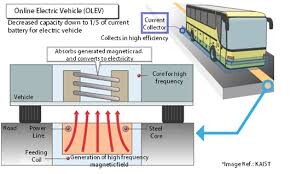hankyoreh
Links to other country sites 다른 나라 사이트 링크
Sejong getting electric buses with inductive charging

Starting this June, Sejong City will begin operating electric buses with inductive charging, which means that they can recharge their batteries while moving or stationary.
On Mar. 10, the Multifunctional Administrative City Construction Agency (MACCA) announced that it had recently reached an agreement with Sejong Transportation and an electric bus company called Olev to operate wirelessly charging electric buses, which are also called Olev (on-line electric vehicles).
Olev, which was developed at the Korea Advanced Institute of Science & Technology (KAIST), received automobile certification in June 2013.

As part of plans to run Olev, MACCA will be building charging facilities at two neighborhoods in Sejong and supplying Sejong Transportation with buses that have a 48-passenger capacity.
Olev, which rely on a technology called “shaped magnetic field in resonance” (SMFIR), are able to operate on electricity that is supplied through the interaction of sensors inside the bus and electric lines installed in the road without any separate connecting wires. Currently, Olev are being used on the campus of KAIST university and in the city of Kumi in North Gyeongsang Province.
It takes 30 minutes for Olev buses to be fully charged, and they can travel for about 40 km on the battery without charging. While the buses have a maximum speed of 85 kilometers per hour, they will travel around 60 kilometers per hour inside the city.
Unlike standard vehicles, which use gasoline or diesel as their fuel, Olev buses do not have an internal combustion engine. This has a number of advantages: they do not have any exhaust fumes, make little noise, and hardly vibrate at all.
“We hope that operating these wirelessly charging electric buses will be a chance to improve our public transportation service and to turn Sejong into an eco-friendly green city based on public transportation,” said MACCA.

By Jeon Jin-shik, South Chungcheong correspondent
Please direct questions or comments to [english@hani.co.kr]
Editorial・opinion
![[Editorial] Does Yoon think the Korean public is wrong? [Editorial] Does Yoon think the Korean public is wrong?](https://flexible.img.hani.co.kr/flexible/normal/500/300/imgdb/original/2024/0417/8517133419684774.jpg) [Editorial] Does Yoon think the Korean public is wrong?
[Editorial] Does Yoon think the Korean public is wrong?![[Editorial] As it bolsters its alliance with US, Japan must be accountable for past [Editorial] As it bolsters its alliance with US, Japan must be accountable for past](https://flexible.img.hani.co.kr/flexible/normal/500/300/imgdb/original/2024/0417/6817133413968321.jpg) [Editorial] As it bolsters its alliance with US, Japan must be accountable for past
[Editorial] As it bolsters its alliance with US, Japan must be accountable for past- [Guest essay] Amending the Constitution is Yoon’s key to leaving office in public’s good graces
- [Editorial] 10 years on, lessons of Sewol tragedy must never be forgotten
- [Column] A death blow to Korea’s prosecutor politics
- [Correspondent’s column] The US and the end of Japanese pacifism
- [Guest essay] How Korea turned its trainee doctors into monsters
- [Guest essay] As someone who helped forge Seoul-Moscow ties, their status today troubles me
- [Editorial] Koreans sent a loud and clear message to Yoon
- [Column] In Korea’s midterm elections, it’s time for accountability
Most viewed articles
- 1[Column] The clock is ticking for Korea’s first lady
- 2Samsung barricades office as unionized workers strike for better conditions
- 3[Editorial] When the choice is kids or career, Korea will never overcome birth rate woes
- 4[Guest essay] How Korea turned its trainee doctors into monsters
- 5Why Israel isn’t hitting Iran with immediate retaliation
- 6S. Korea, Japan reaffirm commitment to strengthening trilateral ties with US
- 7Japan officially says compensation of Korean forced laborers isn’t its responsibility
- 8[Editorial] As it bolsters its alliance with US, Japan must be accountable for past
- 9Korea, Japan jointly vow response to FX volatility as currencies tumble
- 10‘Right direction’: After judgment day from voters, Yoon shrugs off calls for change